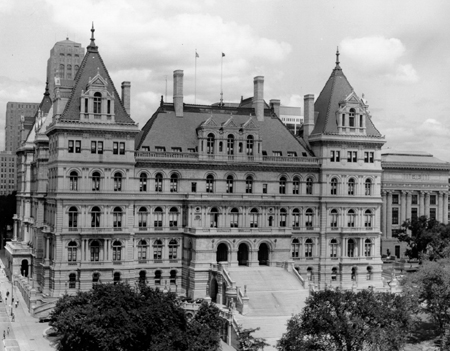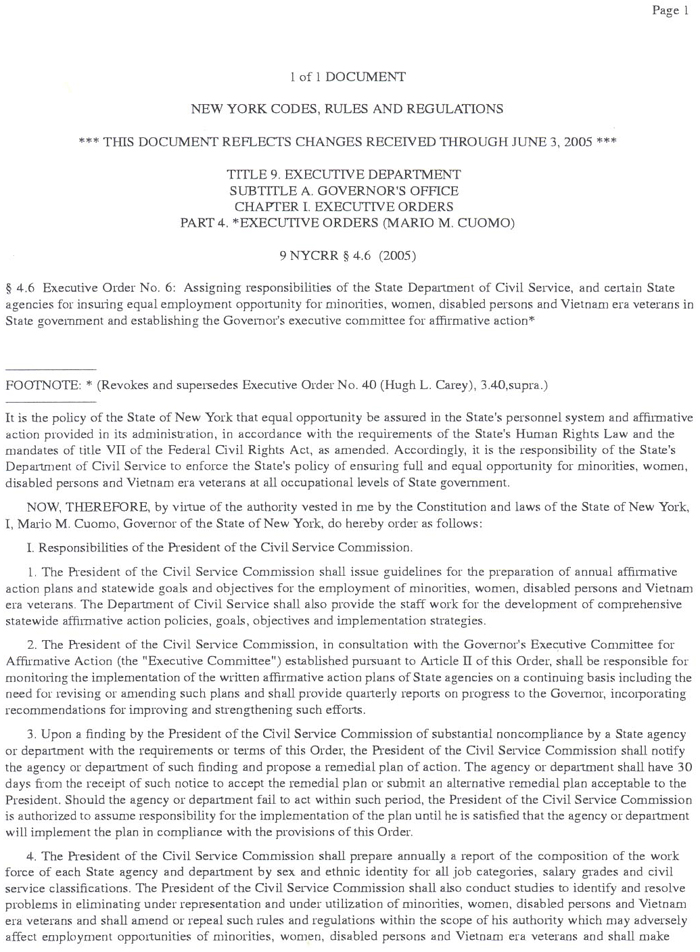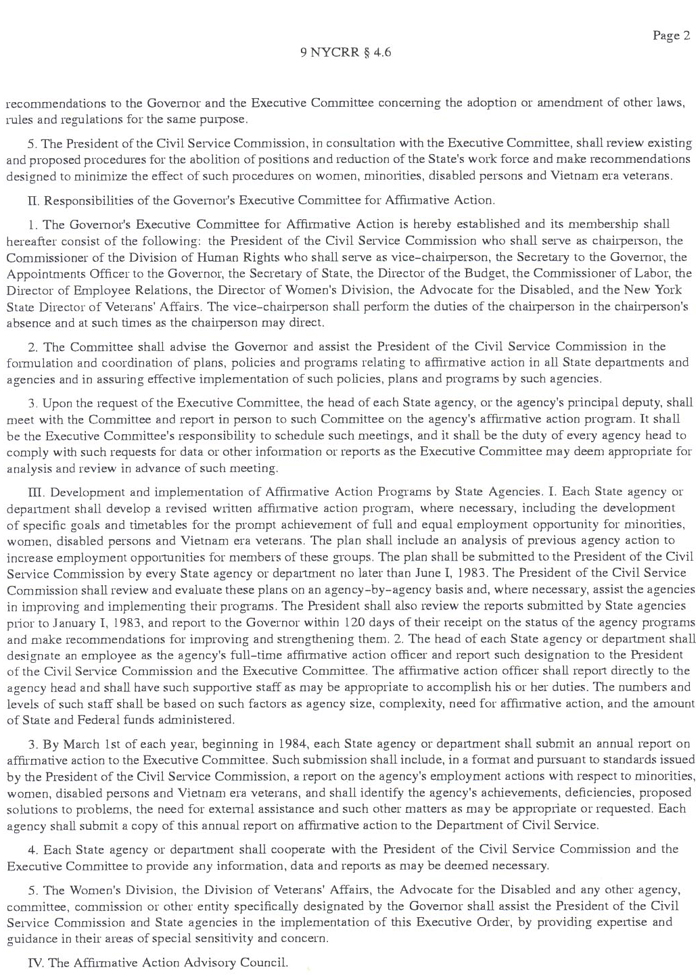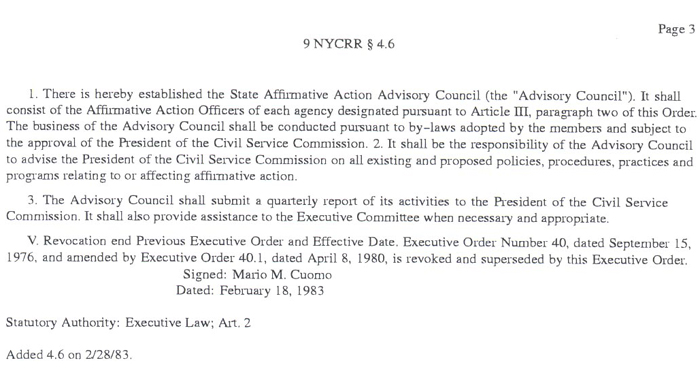|
INTRODUCTION
The Hispanic community in New York State faces both opportunities and challenges as it enters the 21st century.
Its size has increased significantly in both absolute and relative terms. Political leadership and economic success
have continued to grow as the community has developed. At the same time, the difficult economic challenges facing
the State often impact this community in extremely negative ways. Workforce participation, income dynamics, educational
issues and upward mobility remain issues, critical to the economic success of Hispanics, African-Americans and other
minorities.
This brief report will highlight the barriers faced by Hispanics and African-Americans in their attempts to become part of
the New York State government workforce over the past 15 years. Failed promises of providing equal employment
opportunity by previous governors have been covered-up by skewed statistics, lack of access to government data, and a
lack of administrative initiative that has cost Hispanics and African-Americans thousands of jobs and deprived these
communities of hundreds of millions of dollars in yearly income.
The trend to down-size government by the current administration in order to provide savings for the state has not provided
any such savings. In fact, it has only created a situation where both Hispanics and African-Americans are tremendously
under-represented in the New York State government workforce. This comes at a time when Hispanics and
African-Americans represent more than six million of the 18 million inhabitants of our state.
While 1 in 3 New Yorkers are Hispanic or African-Americans, there is a total disconnect from this reality throughout state
agencies. In top administrative and policy making positions, Hispanics and African-Americans are almost non-existent.
Concurrently, as the New York State government workforce ages out of the system, the New York State Department of Civil
Service has done nothing to address this disparity or aggressively outreach into these communities to recruit what will be
its future workforce.
This situation is unacceptable considering the explosion of growth within these communities and their growing presence
throughout New York. Old excuses, such as blaming the limited geographic distribution of minorities for their
under-representation in state government jobs, no longer hold any truth. Hispanic communities throughout New York have
faced triple digit growth in upstate communities and there are more minorities in and around upstate cities than ever before.
This problem is of tremendous importance to the New York State Assembly Puerto Rican/Hispanic Task Force and is one
that will be the focus of hearings and legislation as the Task Force moves to address the terrible discrepancies and
obstacles faced by the Hispanic worker in entering public service in New York State.
Based on the numbers presented in this report, it can easily be said that the New York State Department of Civil Service
has done a great disservice to the minority workforce of the Empire State. The Task Force will seek to play an important
role in the development and implementation of a fair workforce planning strategy. It is obvious that such intent is absent
from the minds of the relatively homogeneous group that encompass the Pataki Administration.
THE FACTS
Hispanic men and women are proportionately the most underrepresented ethnic group in New York State government
agencies and at their present rate of employment will never be able to reach their present general labor force participation
rate of 13.9%.
While this is a problem that has long existed, it has worsened under the administration of Governor George E. Pataki.
Hispanics did see an increase in their participation in the Cuomo administration. However, that growth was small and
has now been reversed. In 1991, during the administration of former Governor Mario M. Cuomo, it was documented that
the rate of participation of Hispanics in the civil service system was growing at a snails pace and that it would take
100 years for the state workforce to reach parity with the 12.3% of the state’s population that was Hispanic.
Today, Hispanics make up over 16% of the entire state population but account for only 3.8% or 6,515 out of the
169,571 jobs in the state government workforce. In real terms, this is a decline in close to 1,000 jobs since 1991.
The 6,515 Hispanics (out of 169,571 total state workers) represent a 12.2% reduction in the number of Hispanic
state workers since Governor Pataki assumed office. This reduction came during a period when the Hispanic
population in New York grew by 33%.
African-Americans have seen the most dramatic decrease in jobs they once held in government service. Since Governor
George E. Pataki took office, African-Americans have lost close to 9,000 jobs and their total participation rate has declined
from 16.5% to 14.3% of New York’s 169, 571 state employees.
Since 1991, the African-American civil service workforce has seen a dramatic decline. The 8,836 jobs lost by this group
represents a 26.7% decline in the African-American state workforce. This reduction came during a period when the
African-American population in New York grew by 13.1%
Simultaneously, from 1991 through 2003, there has only been a reduction of 2.8% in the number of white employees in
the civil service system in New York. Their total participation rate in government employment is 72.7% versus 75.5% in
1991.
Since 1991, the reduction in state workforce accounted for a reduction of over 21,000 jobs held by whites and close to
10,000 jobs held by minorities. It appears that the Department of Civil Service is quick to cut jobs that represent the actual
share of minorities in the general labor force but just as quick to not hire from those groups based on the same
percentages. In other words, 1 in 3 New Yorkers is Hispanic or African-American. One in three jobs cut from the system
belonged to Hispanic or African-American. When hiring is allowed, those percentages are discarded to the detriment of
minorities.
The social and economic consequences of these job losses at a time when both populations are experiencing tremendous
population growth is severe and troubling, while depriving these communities of hundreds of millions of dollars in annual
salaries that are needed to maintain families and neighborhoods.
The impact of these discrepancies needs diligent and further evaluation, including the dramatically low numbers of
Hispanics and African-Americans in management positions within the system. In some agencies, there are no minorities
in policy making or management positions at all. Some of these agencies also happen to employee the bulk of the
minorities in the civil service system, most caught in entry level positions with little opportunity for upward mobility.
TWENTY YEARS OF DATA. SAME PROBLEM!
There was some progress in the hiring of Hispanics as indicated in figures obtained from the New York State
Department of Civil Service that tracked Hispanic participation in between 1984-1990.
In a period of five years, the State of New York allocated 20,127 jobs through its government agencies, of which
8 percent went to Hispanics. That increase brought the number of Hispanics in state service up from 2.9% in
1984 to 3.5% in 1990.
In total, 1,678 jobs went to Hispanics at an average rate of 1.6% per year. While 92% of the jobs created in that
period went to non-Hispanics.
In 1990, in order for Hispanics to reach immediate parity in state government workforce, they would have had to
secure an additional 8, 290 jobs immediately. That under-representation of Hispanics in the labor force deprived
Hispanic communities more than $126 million dollars annually. This is based on an average salary of $25,000 per
employee.
Today the problem has only worsened. While both the Hispanic and African-American communities
continue to grow and their participation in the general labor force has increased there is no translation of that growth
into state government jobs.
The economic loss to these communities is tremendous. If Hispanics were to reach immediate parity in state jobs
with their rate of participation in the general workforce of 13.19% there would need to be an immediate hiring of 17,224
Hispanics by the New York State Department of Civil Service.
The inability to access these jobs translates into a loss of over $860 million in annual salaries. This is based
on the fact that 45% of the state workforce receives a salary ranging from $41,000 to $65,000. At an average salary of
$53,000, the under-representation of Hispanics in the Civil Service system by 17,224 jobs translates into a staggering
loss of wages flowing into these communities.
For African-Americans, the loss of the 8,836 jobs at the average salary of $53,000 translates into a loss of over
$468 million dollars in annual salaries. This is a tremendous loss when considering the socially and economically
devastating rate of unemployment in the African-American communities.
Nationally, Hispanics comprise 11.8% of the private sector labor force and 13.9% of the non-government workforce in
New York. However, according to New York State Department of Civil Service data, they only account for 6,515 of the
169, 571 jobs in state government.
African-Americans, who once held on of every six jobs in state government have seen their participation dwindle since
1991. Presently, African-Americans only comprise only 14.3% of the state workforce even though they have experienced
substantial population growth in all regions of New York State. African-Americans account for close to 16% of the private
sector labor force in New York.
Combined with the fact that 50% of African-American males are unemployed and the fact that there are close to 9,000
less African-Americans working in civil service since the Pataki Administration took office, the economic impact on this
community is substantial.
Another area for further evaluation and where more information is needed is the concentration of Hispanics and
African-Americans in the lowest salary grades provided by the Department of Civil Service and what mechanism,
including training opportunities, are now being made available to these groups to assist them in upward mobility.
This is important because 17.5% of the civil service system is composed of individuals 55-64 years of age. This is
critically important because the system allows retirement at 55. Who will be in the next wave of workers needed by
the system as the aging of the State workforce accelerates? This is a question that needs to be explored.
THE GOVERNOR’S ROLE
The figures released by the New York State Department of Civil Service on its workforce clearly indicate problems in
the hiring of Hispanic and African-Americans and reveals administrative problems, lack of political will and fair initiatives
to address the under-representation of minorities in the system. There is obvious need for concern over job opportunities
for Hispanics and African-Americans in state government.
The Pataki Administration feels rather comfortable with the level of minority participation in the State’s workforce.
2003 data released by the New York State Department of Civil Service indicates that the Governor’s own office
shows the imbalance that exists in the entire system.
Of the 196 employees of the Executive Chamber, six are Hispanic (3.1%) and five (2.6%) are African-American.
79.6% working in the Governor’s Office are white. Civil Service can not account for the ethnicity of the other 12.6%.
Public policy experts have commented that the lack of diversity at the top levels of government is a factor that contributes to
bad government policies that negatively impact those under-represented. It also shows a clear disregard for basic issues
of fairness and equal employment opportunities that serve to marginalize Hispanics and African Americans.
For a governor interested in national office, the lack of access by Hispanics and African-Americans goes against national
trends to be more inclusive as they recognize that inroads need to be established into minority communities.
According to a recent report by the Center for Women in Government & Civil Society, the numbers of African-American
appointees in New York are the nation’s worst even though almost 16% of New Yorkers are African-American. Less
than 5% of Governor Pataki’s appointments are African-American.
The lack of diversity in the Governor’s Office might have prompted the recent statement by Todd Alhart, a spokesman
for the Governor when he said, "We are tremendously proud of the diverse group of leaders that we have in this
administration."
EQUAL EMPLOYMENT OPPORTUNITY?
The problem of diversity within the State’s workforce has been also blamed on the complacency of the
Affirmative Action Officers towards their agency’s attempt to ignore equal employment opportunity rules.
Hispanic policy maker have said the situation has deteriorated and considerable work is needed to fix the problem.
Newsletters produced by the New York State Affirmative Action Advisory Council have been found to congratulate state
agencies for their equal employment opportunity efforts while the reality is far from the truth.
The advisory council was created in 1983 by former Governor Mario M. Cuomo under Executive Order Number Six.
The council consists of the affirmative action officers of each agency. Their responsibility is to advise the president
of the Civil Service Commission on all existing and proposed policies, procedures, practices, and programs relating
to affirmative action.
Observers of the process indicate that affirmative action officers feel that they are being blamed for the under-representation
of Hispanics and African-Americans in the system. The fact is that those officers are in exempt, provisional, or in
non-competitive positions that leave them extremely vulnerable to retaliation when they try to perform their duties and
responsibilities.
Affirmative action officers should be provided a competitive or permanent employment structure which would allow them to
work without fear of losing their employment without a grievance procedure.
There is growing concern throughout the Hispanic and African-American communities that modest gains made last
decade are being eroded and more jobs will be lost as the State’s fiscal problems worsen. The system needs to
be monitored from the outside to ensure that Hispanics and African-Americans are not being forced out of the system and
that additional employment obstacles are not in place for positions that do become available as civil servants age-out of the
system.
In order for state agencies to reduce their workforce, they must submit a report of their proposed workforce reduction plans
for approval to the New York State Division of the Budget and to the Department of Civil Service.
Once at the Department of Civil Service, it is subject to their rules and regulations. It is the responsibility of the Department of
Civil Service to ensure full and equal opportunity for minorities, women, disabled persons and Vietnam era veterans.
Under Executive Order Number Six, the president of the Civil Service Commission has the authority to take over any
agency’s affirmative action program when there is a finding of substantial non-compliance. In review of 2003
civil service data, this is an action that should have been taken dozens of times over the past decade.
Executive Order Number Six also created the Governor’s Committee for Affirmative Action. The committee’s
duty is to advise the Governor and assist the President of the Civil Service Commission in the formulation and coordination
of plans to effectively implement affirmation action in all state agencies. It is unclear if Governor Pataki has ever convened
this committee and what its role has been over the past 10 years.
The committee consists of the President of the Civil Service Commission, the Commissioner of the Division of Human
Rights, the Secretary to the Governor, the Appointments Officer to the Governor, the Secretary of State, the Director of the
Budget, the Director of Employees Relations, the Director of the Women’s Division, the Advocate for the Disabled
and the Director of Veterans Affairs, none which are Hispanic.
BREAKING DOWN THE BARRIERS
The problem of the lack of diversity within the State’s workforce has been also blamed on many factors. Those
that believe the system is working fairly are unable to provide a complete picture of the salary levels, job titles and
employment opportunities for the groups that are under-represented in New York’s Civil Service system.
The problem the under-representation of Hispanics and African-Americans in management and policy making positions
within New York State government is even more troubling then the figures provided in this report. This is also an issue
that needs further investigation and analysis. This serious problem beckons for action.
It is not an overstatement to claim that the future of our Democracy rests on the delicate balance of power and sharing of
resources. The fairness in any process developed needs to be clear, especially in an increasingly diverse society where
groups are competing for those resources. Without a transparent process of cooperation that allows for that participation,
our system of government is threatened and the social interactions between competing groups are further strained.
It is clear that the New York State Legislature will have to hold public hearings in order to gather all of the relevant information
needed for further analysis of the impact of current situation and practices. A State commission needs to be established for
the purpose of:
-
gathering best practice approaches in the work to increase diversity;
-
oversee the implementation of new approaches chosen to tackle the problem; and
-
helping to establish a process by which those aging out of the current system will be replaced by those
under-represented.
A few suggestions on possible solutions are described below:
-
Support and fully implement Executive Order Six;
-
Provide employment information to students, college faculty, and minority communities;
-
Use the Presidential Management Intern (PMI) Program model for recruiting and advancing Hispanic
and African-American college graduates;
-
Participate in the direct campus outreach throughout the SUNY and CUNY system of colleges;
-
Use any flexabilities that exist in the Civil Service system to bring Hispanic students into jobs classified as
shortage category occupations, as well as other occupations; and
-
Develop and promote participation of minority employees in career development programs.
THE AGENCIES WITH THE WORST HIRING PRACTICES
The following data from the 2003 New York State Workforce Management Report compiled by the New York State
Department of Civil Service documents the lack of diversity in selected state agencies.
|



